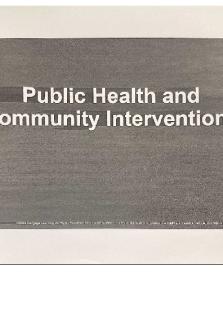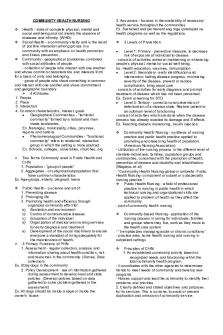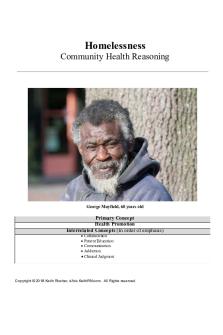COMMUNITY PUBLIC HEALTH LECTURE REVIEWER PDF

| Title | COMMUNITY PUBLIC HEALTH LECTURE REVIEWER |
|---|---|
| Course | Medical Laboratory Science |
| Institution | Angeles University Foundation |
| Pages | 5 |
| File Size | 364.3 KB |
| File Type | |
| Total Downloads | 71 |
| Total Views | 159 |
Summary
Download COMMUNITY PUBLIC HEALTH LECTURE REVIEWER PDF
Description
COMMUNITY & PUBLIC HEALTH FOR MEDICAL LABORATORY SCIENCE Module 1: (CPH LEC) College A.Y. 2021 – 2022 – 2 Foundation of Public Health
TOPIC OUTLINE I. Definition of Terms II. Determinants of Health III. Essential Public Health Services IV. History of Community and Public Health A. Early Civilizations B. Medieval and Renaissance Period C. 18th century D. 19th Century E. 20th and 21st Century DEFINITION OF TERMS HEALTH • “Hælp” and old English word that means whole, sound or well. • According to WHO - Health is defined as the highest possible level or state of complete physical, mental and social well-being and not merely the absence of disease. COMMUNITY • In a traditional sense community is - Geographic are with specific boundaries. • Community Public Health - It is a collective body of individuals identified by common characteristics: - Geography - Interests - Experiences - Concerns - Values ‣ Community Elements: • Membership - Sense of identity and belonging. • Common Symbols - Refer to similar languages, rituals, and ceremonies. • Shared Values - Refers to values and beliefs for a particular society. • Mutual Influence - Community members that have influence and are influenced by each other within the community. • Shared needs and commitments - Members that share a common history, experiences, and have a mutual support for each other. • Shared emotional connections - Members that share a common history, experiences, and have a mutual support for each other.
PUBLIC HEALTH • “The science and art of preventing diseases, prolonging life, and promoting health and efficiency through organized community effort… to ensure everyone a standard of living adequate for the maintenance of health.” — Charles-Edwards Amory Winslow PUBLIC HEALTH SYSTEM • It is the organizational mechanism of those activities undertaken within the formal structure of government and the associated efforts of private and voluntary organizations and individuals. COMMUNITY HEALTH • It is the health status of a defined group of people and the actions and conditions to promote, protect, and preserve their health. POPULATION HEALTH • It is the health outcomes of a group of individuals, including the distribution of such outcomes within the group. GLOBAL HEALTH • It describes health problems, issues, and concerns that transcend national boundaries, may be influenced by circumstances of experiences in other countries, and are best addressed by cooperative actions and solutions. PERSONAL HEALTH ACTIVITIES • Individual actions and decisions that affects the individuals health. • Preventive or curative in nature. • Seldom directly affects others. COMMUNITY AND PUBLIC HEALTH ACTIVITIES • Aimed at protecting or improving health of a population or community. DETERMINANTS OF HEALTH I. Physical Determinants • Geography - A communities health problems may be directly influenced by it (e.g. altitude, latitude, and climate). • Environment - Quality of a natural environment that is directly related to the quality of our stewardship of it.
Lopez, A. K. A. (BSMT 1-B)
!! 1 | 5
COMMUNITY & PUBLIC HEALTH FOR MEDICAL LABORATORY SCIENCE Module 1: (CPH LEC) College A.Y. 2021 – 2022 – 2 Foundation of Public Health
• Community Size - The larger the community, the greater its range of health problems and the greater its number of health resources. • Industrial Development - Industrial Development like size can have either positive or negative effects on the health status of a community. - It provides a community with added resources for a community health programs, but it may bring with it environmental pollution and occupational injuries and disorders. II. Socio-Cultural Determinants • Beliefs, Traditions, and Prejudice - The beliefs of those in a community about such specific health behavior as exercise and smoking can influence policy makers on whether or not they will spend money. - The traditions of specific ethnic groups can influence the types of foods, restaurants, retail outlets, and services available for a community. - For prejudice of one specific ethnic or racial group against another can result in acts of violence and crime in which racial and ethnic disparities will continue to put certain groups at a greater risk. • Economy - Both national and local economies can affect the health of a community through reductions in health and social services. An economic downturn means lower tax revenues; meaning that we have a fewer money to spend on the services. • Politics - Those who are in political office can improve or jeopardize the health of their community by their decisions. • Religion - A number of religions have taken a position on health care and health behaviors. - Some religious communities limit the type of medial treatment their members may receive. • Social Norms - Influence of social norms on community and public health can be positive or negative and can change over time. • Socio-economic Status - Difference on socio-economic status whether defined by eduction, employment, or income, both individual
and the community level economic status have independent effects on health. - There is a strong correlation between social economic status and health status. III. Community Organizing • The process by which community groups are helped to identify common problems or change targets, mobilize resources, and develop and implement strategies for reaching their collective goals. IV. Individual Behavior • The behavior of an individual community member contributes to the health of the entire community. • It takes the concerted effort of many if not most of the individual in a community to make a program work. ESSENTIAL PUBLIC HEALTH SERVICES 10 GREATEST PUBLIC HEALTH ACHIEVEMENTS 1. 2. 3. 4. 5.
Vaccination Motor Vehicle Safety Safer Workplaces Control of Infectious Diseases Decline of deaths from coronary heart disease and stroke. 6. Safer and Healthier Foods 7. Healthier Mothers and Babies 8. Family Planning 9. Fluoridation of drinking water 10.Recognition of Tobacco use as a health hazard. ASSESSMENT • Assessment is the evaluation or estimation of the nature quality or ability of someone or something. • Assess and monitor population health. • Investigate, diagnose and address health hazards and root causes. POLICY DEVELOPMENT • Communicate effectively to inform and educate. • Strengthen, support and mobilize communities and partnerships. • Create, champion and implement policies, plans and laws. • Utilize legal and regulatory actions.
Lopez, A. K. A. (BSMT 1-B)
!! 2 | 5
COMMUNITY & PUBLIC HEALTH FOR MEDICAL LABORATORY SCIENCE Module 1: (CPH LEC) College A.Y. 2021 – 2022 – 2 Foundation of Public Health
ASSURANCE • Assurance is a positive declaration intended to give confidence. • Enable equitable access. • Build a diverse and skilled workforce. • Improve and innovate through evaluation, research and quality improvement. • Build and maintain a strong organizational infrastructure for public health. HISTORY OF COMMUNITY AND PUBLIC HEALTH A. EARLY CIVILIZATIONS • The ideas and practices of primitive cultures varies in accordance with geography and historical heritage. • Primitive cultures do not distinguish between medicine, magic, and religion. • Disease and death are works of the supernatural. ‣ Ancient Chinese Civilization • Basic concept of health: Yin (Female) and Yang (Male); emphasis on a balanced lifestyle. • Medical Care focuses on the following: - Diet - Herbal Medicine - Hygiene - Massage, and acupuncture. ‣ Ancient Indian Civilization • Ancient Cities - Building codes, paved streets, and covered sewage drains. • Indian Medicine - Herbalism • Ayurvedic Medicine • Laws of Manu - Personal hygiene, sanitation, and water supply engineering. ‣ Ancient Egyptian Civilization • Widespread Parasitic Diseases - Agriculture and irrigation practices. • Egyptian Medicine - Surgical skills and organization of medical care. • Ancient Egyptian Medical Papyrus Papyrus Name
Medical Specialties
Edwin Smith Papyrus
Oldest textbook on trauma surgery
Eber’s Papyrus
Medicine, ObstetricGynecology, and Surgery
Kahun Papyrus
Medicine, ObstetricGynecology, Pediatrics, and Veterinary Medicine
Ramesseum Papyrus
Medicine, Gynecology, Ophthalmology, Rheumatology, and Pediatrics
Hearst Papyrus
Medicine, Urology, and Bite Treatment
London Medical Papyrus
Skin and eye complaints, Bleeding, Miscarriage, and Burns
Brusch Papyrus
Medicine
Carlsberg Papyrus
Medicine, ObstetricGynecology, Pediatrics, and Ophthalmology
‣ Ancient Hebrew Civilization • Health revolves around the Hebrew Mosaic Law of the Five Books of Moses: - Personal and community hygiene. - Reproductive and maternal health. - Isolation of lepers and other “unclean conditions”. - Family and personal sexual conduct. - Medical and public health jurisprudence. ‣ Ancient Greek Civilization • High emphasis on Healthful Living: - Personal Hygiene - Nutrition - Physical fitness - Community Sanitation • Hippocrates - He collected his ideas in a manuscript which was entitled as “Air, Water and Places.” - He discussed in the manuscript the reasoning behind different diseases that were experienced during those times. • Ancient Greek civilization individuals and communities or societies believe that diseases came from bad air which was termed as “Miasma” or “Pollution”.
Lopez, A. K. A. (BSMT 1-B)
!! 3 | 5
COMMUNITY & PUBLIC HEALTH FOR MEDICAL LABORATORY SCIENCE Module 1: (CPH LEC) College A.Y. 2021 – 2022 – 2 Foundation of Public Health
‣ Ancient Roman Civilization • Bad health was caused by bad water and sewage • Greatest achievement of the Roman Empire — Installation of drains, sewers, for sewage disposal. • Aqueducts channeled fresh water from the mountains down to their cities. B. THE MEDIEVAL & RENAISSANCE PERIOD ‣ Medieval Catholic Europe • Dominance of the Church sets a rigid framework for medieval practices particularly focusing on health and hygiene. • Plagues; believed to be caused by divine retribution because of how many sinners they had during those times. • Clerics; are the only approved physicians. • Epilepsy and the mentally ill; are considered as demonic possessions; treatment that they received was exorcism. • Leprosaria; institutions where lepers were kept from the general population. ‣ Medieval Islamic East • Rhazes (Abu Bakr Muhammad ibn Zakariyya al-Razi) and Avicenna (Ibn Sinna) ; Persian physicians who adapted classical medical teachings. • Rhazes - A Physician who is widely considered as one of the most important figures in the history of medicine. - According to the 1911 edition of the Encyclopedia Britannica, He was among the first to use the humoral theory to distinguish one contagious disease from another. - He wrote a pioneering book about smallpox and measles providing clinical characterization of diseases. • Avicenna - He is regarded as one of the significant physicians whose most famous works are the: “Book of Healing” a philosophical and scientific in Christ Encyclopedia and the “Canon of Medicine” a Medical Encyclopedia which became a standard medical text at many medieval universities and remained in use as late as 1650. • The Cordova Medical Academy - An academy which was established in Cordova during the islamization of Spain.
- It focuses on medical knowledge and scholarship. - Paved the way for modern European medical thinking. C. THE 18TH CENTURY • Edward Jenner - Father of Immunology - “An Inquiry into the Causes and Effects of the Variolae Vacciniae” - The word “vaccination” was coined bay Jenner back in 1796 from a latin adjective which is “vaccīnus” meaning from a cow. - Jenner noticed that his milkmaid (Sarah Nelmes) was infected with cowpox and was basically immune to smallpox which was a common disease during those times. - Noting the common observation will milkmaids were generally immune to smallpox; Jenner postulated that the pus in the blisters that milkmaids received from cowpox protected them form smallpox. - Cowpox is a similar disease to smallpox but a much less virulent type of virus. - May 14, 1796, Jenner tested his hypothesis by inoculating an 8-year-old boy named James Phipps with pus, that Jenner collected from Sarah Nelmes; Phipps later fell ill and developed a mild form of cowpox later, he was injected with a various materials (any form of materials from those patients suffered from smallpox). That was a routine method for immunization at that time. D. THE 19TH CENTURY • John Snow - Father of Epidemiology - He investigated Cholera in the Cholera epidemic in London, England during those times. • Robert Koch - Father of Modern Bacteriology - Discovered the causative agents for Tuberculosis, Cholera, and Anthrax. • Noteworthy Discoveries Year
Discovery
C.A.
1879
C.A. Leprosy
Mycobacterium leprae
Lopez, A. K. A. (BSMT 1-B)
!! 4 | 5
COMMUNITY & PUBLIC HEALTH FOR MEDICAL LABORATORY SCIENCE Module 1: (CPH LEC) College A.Y. 2021 – 2022 – 2 Foundation of Public Health
C.A. of Tuberculosis
Mycobacterium tuberculosis
C.A. of Diphtheria
Corynebacterium diphtheriae
C.A. of Pneumonia
Streptococcus pneumonia
Arthur Nicholaier discovered the cure for Tetanus
Clostridium tetani
1882
1884
Cocaine is used as a local anaesthetic 1890
Rubber gloves were 1st used in operations C.A. of The Plague
Yersinia pestis
1894 Aspirin E. THE 20TH AND 21ST CENTURY ‣ The 20th Century • Life expectancy less than 50 years old. - Due to the spread of communicable diseases (Spanish Flu) and the two world wars (WW1& WW2). • Leading cause of disease: - Communicable and infectious diseases.
‣ The 21st Century • Period of Health Promotion - “Process of enabling people to increase control over, and to improve their health.” • Leading Cause of Disease - Lifestyle diseases • Challenges: - Increasing health care cost. - Emerging and re-emerging diseases.
Lopez, A. K. A. (BSMT 1-B)
!! 5 | 5...
Similar Free PDFs

Community health final
- 14 Pages

Community Health Nursing RLE
- 15 Pages

Community Health Diagnosis
- 136 Pages

ATI Community Health Focus
- 24 Pages
Popular Institutions
- Tinajero National High School - Annex
- Politeknik Caltex Riau
- Yokohama City University
- SGT University
- University of Al-Qadisiyah
- Divine Word College of Vigan
- Techniek College Rotterdam
- Universidade de Santiago
- Universiti Teknologi MARA Cawangan Johor Kampus Pasir Gudang
- Poltekkes Kemenkes Yogyakarta
- Baguio City National High School
- Colegio san marcos
- preparatoria uno
- Centro de Bachillerato Tecnológico Industrial y de Servicios No. 107
- Dalian Maritime University
- Quang Trung Secondary School
- Colegio Tecnológico en Informática
- Corporación Regional de Educación Superior
- Grupo CEDVA
- Dar Al Uloom University
- Centro de Estudios Preuniversitarios de la Universidad Nacional de Ingeniería
- 上智大学
- Aakash International School, Nuna Majara
- San Felipe Neri Catholic School
- Kang Chiao International School - New Taipei City
- Misamis Occidental National High School
- Institución Educativa Escuela Normal Juan Ladrilleros
- Kolehiyo ng Pantukan
- Batanes State College
- Instituto Continental
- Sekolah Menengah Kejuruan Kesehatan Kaltara (Tarakan)
- Colegio de La Inmaculada Concepcion - Cebu











